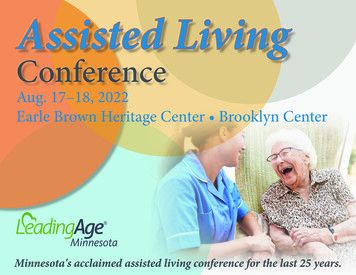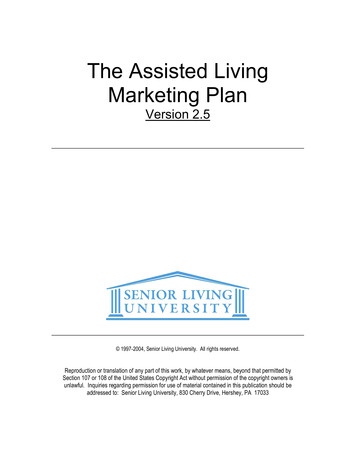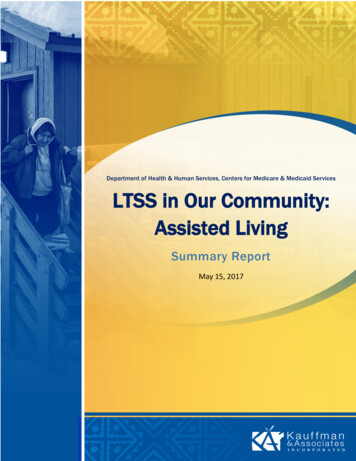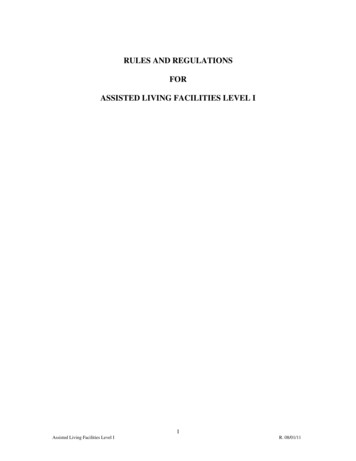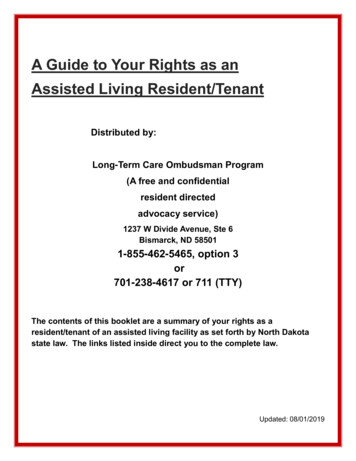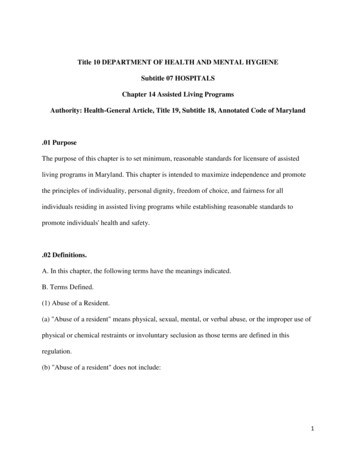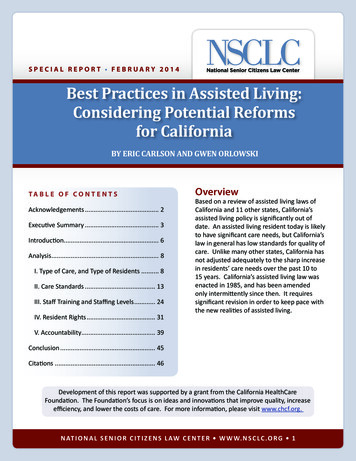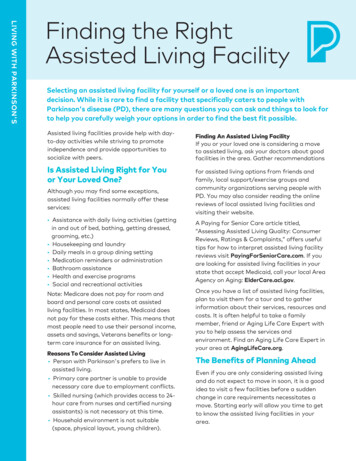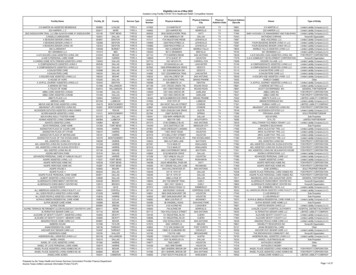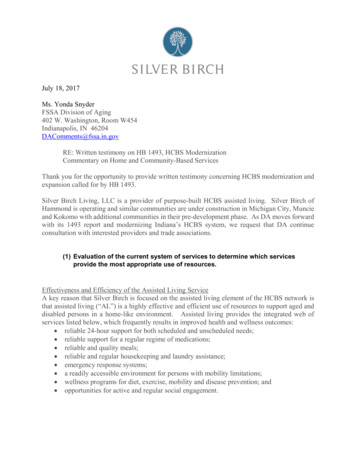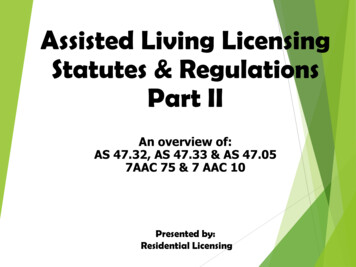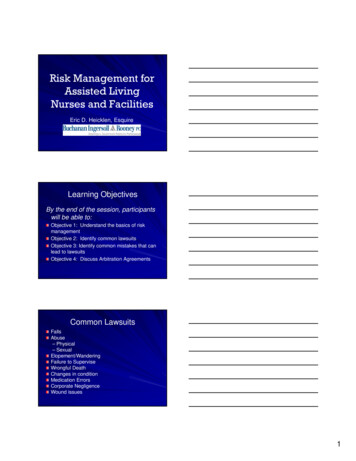
Transcription
Risk Management forAssisted LivingNurses and FacilitiesEric D. Heicklen, EsquireLearning ObjectivesBy the end of the session, participantswill be able to:Objective 1: Understand the basics of riskmanagementObjective 2: Identify common lawsuitsObjective 3: Identify common mistakes that canlead to lawsuitsObjective 4: Discuss Arbitration AgreementsCommon LawsuitsFallsAbuse– Physical– SexualElopement/WanderingFailure to SuperviseWrongful DeathChanges in conditionMedication ErrorsCorporate NegligenceWound issues1
Mistakes That Lead to Lawsuits“Rubber stamp” physician ordersLack of communication during transfers betweenfacilities; i.e. hosptial to ALF or nursing homeNot documenting discussions withstaff/physicians and residents/familiesNot documenting that lab results are sent andreviewedNot ensuring that orders are implemented anddocumented in the correct portions of the chartPoor documentation on MARs and TARsRecords issuesAlzheimer’s Residents: A GrowingTrend in LitigationIs the resident appropriate for Assisted Living?Blurring of lines between an AL and a NHresidentDoes the family understand the naturalprogression of the disease?Is the family prepared for the behaviors thatoften occur with the disease?Are educational materials provided?Are conversations/information provided tofamilies documented?– Doctor has the conversation, but its not documentedAlzheimer’s/Dementia Units“Locked in” units– Keypad accessLarge common areasActivities to provide cognitive stimulationClose supervisionElopement/Wandering risks– Wander Guards– Alarmed doors2
Plaintiff’s Litigation TacticsCorporate theories of liability– Attack the corporation– Focus on staffingN.J.A.C §8:36-5.6(c)– Lack of policies and procedures– Violation of policies and procedures– Lack of physician oversight– Failure to follow federal and state regulations– Failure to provide necessary resources to thefacility– State surveysStaffingN.J.A.C. §8:36-5.6(c)– The staffing level in this chapter is minimumonly and the assisted living residence,comprehensive personal care, or assistedliving program shall employ staff in sufficientnumber and with sufficient ability and trainingto provide the basic resident care, assistance,and supervision required, based on anassessment of the acuity of residents' needs.Plaintiff’s Litigation Tactics“Split the Defense”Attending physician v. staffNurses v. CNAsDisgruntled former employees– complaints about staffing– inadequate resources to do their jobs– Plaintiff’s attorneys hire investigators to locateformer employees3
Plaintiff’s Litigation TacticsPolicies and Procedures– Argue facility violated it’s own standardsWhat is being marketed to families?– Does the facility meet its marketing promises?– Are families given unrealistic expectations?– Are families provided explanations of staffing,physician visits and limitations of services?– Is there communication with resident and/orfamily about medical condition?– Does resident/family understand the role of anALF?Is this understanding documented?Risk ManagementProviding good careHiring/retaining competent and caring staff– Orientation for new staff– Annual performance reviewsKnowing what mistakes are made that lead tolawsuits– In-ServicesGood documentation and family relationsExplaining conditions and difficult medical issuesto the resident and family in a way that createstrust and realistic expectationsALFs v. SNFsIs there really a distinction between ALFsand skilled nursing facilities?NJ Resident Rights Statute - SNFsHow many times is the term “care” used inlawsuits?What does public expect assisted livingfacilities to provide to residents?– What would a jury think?– Do residents/families realize the staffingrequirements?4
Perceptions and LawsuitsFamilies and attorneys may have adifferent view of the role of the ALFCommunity perception of an ALF– JurorsDocumentation is crucialDon’t expect that just explaining theresident’s condition or residency will avoida lawsuitBuild relationships with residents/familiesDeposition of an Executive DirectorRegulations – Standard of Care?StaffingSurveysPolicies and proceduresCorporate Structure and Reporting to"Corporate"BudgetingHiring and Firing of StaffBonusesDocumentationIn-Services and Staff OrientationInvolvement in Resident Care/ResidentInteractionArbitration AgreementsA Contract that requires all disputesbetween a resident and a long term carefacility to be resolved through bindingarbitration before a neutral arbitrator asopposed to a judicial forumFederal Arbitration ActState Arbitration Acts and StatutesProvided/explained to resident/family uponadmission5
Arbitration Agreements– Places fact finding and decision makingpowers in the hands of professionalattorney/arbitrator as opposed to a lay jury– Limits discovery, witnesses, experts and otherprocedures– Valid arbitration agreements remove a casefrom the court’s jurisdictionChallenges to Enforceability– An agreement is procedurally unconscionableif its terms were accepted by the weaker partywith no reasonable choice, as in a contract ofadhesioni.e. Must sign agreement in order to receivecare– An agreement is substantivelyunconscionable if its terms unreasonablyfavor the other partyi.e. limitations on damages; restrictions ondiscoveryConclusionTwo things to remember:–1) Documentation; and–2) Communication.THANK YOU!QUESTIONS?6
Involvement in Resident Care/Resident Interaction Arbitration Agreements A Contract that requires all disputes between a resident and a long term care facility to be resolved through binding arbitration before a neutral arbitrator as opposed to a judicial forum Federal Arbitration Act State Arbitration Acts and Statutes

